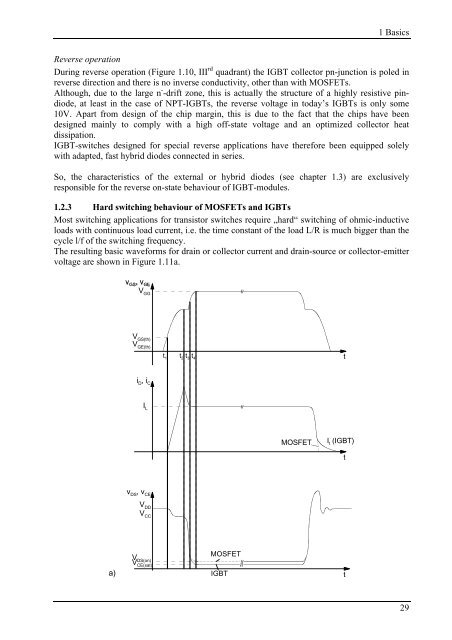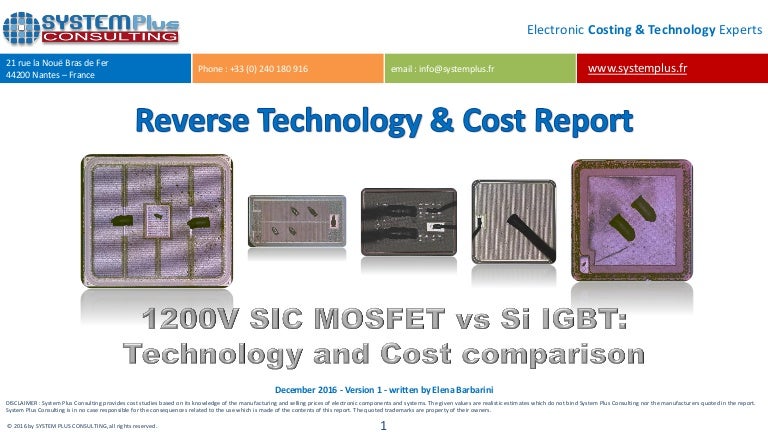
IGBT derives its advantages from MOSFET and BJT. It operates as a MOSFET with an injecting region on its Drain side to provide for conductivity modulation of the Drain drift region so that on-state losses are reduced, especially when compared to an equally rated high volt-age MOSFET. As far as driving IGBT is concerned, it resembles a MOS. As mentioned earlier an IGBT is a fusion between a BJT and MOSFET. The symbol of the IGBT also represents the same, as you can see the input side represents a MOSFET with a Gate terminal and the output side represents a BJT with Collector and Emitter. Fundamentals of MOSFET and IGBT Gate Driver Circuits The popularity and proliferation of MOSFET technology for digital and power applications is driven by two of their major advantages over the bipolar junction transistors. One of these benefits is the ease of use of the MOSFET devices in high frequency switching applications.
MOSFET Vs IGBT
In today’s world there are wide varieties of solid-state, switch-mode, power-supply transistors to perform switching operations in power-electronic systems. All these have their own specifications in terms of current, voltage, switching speed, load, driver circuitry and temperature. Each one has its limitations and advantages as well, but its usage depends on the requirements of the application.
In most of the switching applications Metal-Oxide Semiconductor Filed Effect Transistor (MOSFET) and Insulated Gate Bipolar Transistors (IGBTs) are predominant than the other switching devices due to their superior characteristics. These applications include Uninterruptable Power Supplies (UPS), Solar Inverters and Converters, various motor driver systems, Pulse Width Modulation (PWM) technique based applications, Switch Mode Power Supplies (SMPS), etc.
Let us see the prominent differences that make these switching devices suitable for appropriate applications. In this regard, the description of the following two switching devices is pertinent.
High-Voltage Power MOSFET
Power MOSFET
MOSFET is a most commonly used switching device, which is voltage-controlled power device unlike the BJT, which is a current controlled device. MOSFET is a low-current, low-voltage and high-frequency switching device. It consists of three terminals: gate, drain and source. It comes with two different modes: enhancement and depletion modes and the MOSFETs can be P-channel or N-channel MOSFETs. MOSFETs vary depending on the voltage level of the gate terminal.
In a depletion mode, maximum conductance takes place between the source and the drain if there is no voltage at the gate terminal, whereas a positive or negative voltage at the gate decreases the conductivity. In an enhancement mode, the MOSFET doesn’t conduct if there is no voltage at the gate terminal, and if the voltage is more, conduction takes place.

If the positive voltage is more than the threshold level applied between the gate and the source, then it creates a conduction layer by accumulating electrons. This layer is formed between the oxide layer and the P-substrate layer by pushing away the holes from the P-substrate and attracting the electrons in the N-layer. With the increase in the gate to source voltage, the size of this conduction layer increases resulting in the flow of more current from the source to the drain. In this way, MOSFET comes into conduction mode by the application of voltage across the gate and source.
MOSFET can be turned off by decreasing the gate to source voltage to below the threshold level of it. Sometimes a BJT current is required to trigger it though the MOSFET is a voltage controlled switch. It also has a body-drain diode useful in dealing with freewheeling current applications. Because its on-state resistance is low, on-state losses are also lower. MOSFETs can operate at high frequencies and low voltages and are perfectly suitable for faster switching operations with low-voltage drops. But these are restricted to be used at higher operating voltages in the range of around 500V.
IGBT (Insulated Gate Bipolar Transistor)
IGBT is designed by combining the features of both MOSFET and BJT in monolithic form. As the BJTs have high current handling capacity and MOSFET control is easy, IGBTs are preferred for medium to high-power applications. Lynda.com macbook pro tutorial torrent download. It is a minority charge carrier device and has high input impedance.
It has three terminals: Emitter, Collector and Gate. The Gate is a control terminal, whereas the collector and emitter terminals are associated for conduction path. IGBT is a four-layer structure P-N-P-N same as that of thyristors. The below figure shows different layers of IGBT, wherein the flow of electrons through the drift region and the channel draw more holes into the drift region towards the emitter. Because the current flow is composed of the holes and electrons, the current is of bipolar nature.
IGBT Structure
Similar to the MOSFET, when the positive gate bias is applied, it allows the inversion of P-base region under the gate and creates N-channel. During this state, the resistance of n- layer is reduced rapidly when the positive holes are injected from the p+ layer to the n- layer. This makes the IGBT to handle more currents than the MOSFET due to lower conduction losses. For turning it off – the negative bias at the gate or lowering the gate voltage to a threshold level makes it off due to no injection of holes to the N region. Biggest paint brush.
Difference between Insulated Gate Bipolar Transistor (IGBTs) and High-Voltage Power MOSFETs
- MOSFET is a majority carrier device wherein the conduction is by electrons’ flow, whereas IGBT is a current flow comprising both electrons and holes. As discussed above, the injection of minority carriers (holes) to the drift region significantly reduces on-stage voltage due to conduction modulation. This is the advantage of low on-state voltage drop compared to MOSFET which is a smaller chip size and less expensive device.
- IGBT is made up of emitter, collector and gate terminals, whereas MOSFET consists of source, drain and gate terminals.
- IGBT usage is predominated for higher voltage applications as it is unipolar and requires additional freewheeling diode for the reverse flow of current. Because of this additional diode across the IGBT – it gives very high performance compared to the MOSFET.
- MOSFET and IGBT structures look very similar except for the P-substrate below the N substrate. Due to this extra layer, the conductivity is increased by the injection of holes that also reduces the on-state voltage as discussed above.
- MOSFET is rated at a voltage of about 600 volts, whereas IGBT is rated at a voltage of about1400V range. Therefore, at high voltages current becomes low eventually resulting in low switching losses.
- IGBT is preferred for low frequency (Less than 20 KHz), high voltage (more than 1000V), small or narrow load or line variations; low duty cycle, high operating temperature; and, more than 5kw output power rating applications; whereas MOSFET is preferred for wide load or line variations, low voltage (Less than 250V), large duty cycles and high frequency (more than 200KHz) applications.
- IGBT typical applications include Uninterruptable Power supplies (UPS), low-power lighting, motor control and welding applications, Switch Mode Power Supplies (SMPS), battery charging, etc., but compared to MOSFET, IGBT is predominated in several applications.
Difference between IGBT and MOSFET
In the above diagram, you can observe some comparisons of IGBT and MOSFET based on their model with ratings. Therefore, for choosing switching devices, especially IGBT and MOSFET devices there are larger parameters to be considered for the corresponding applications in power electronic field. For any application-based projects on these devices, you can contact us by commenting below.
Photo Credits:
- Power MOSFET by nlvocables
- MOSFET Structure by circuitstoday
- Insulated Gate Bipolar Transistor by cloudfront
- IGBT Structure by lchu
- Difference between IGBT and MOSFET by powersystemsdesign
MOSFET vs IGBT | difference between MOSFET and IGBT
This page compares MOSFET vs IGBT and mentions tabular difference between MOSFET and IGBT.MOSFET full form is Metal Oxide Semiconductor Field Effect Transistor and IGBT full form is Insulated Gate Bipolar Transistor.
What is MOSFET and its full form ?
Mosfet And Igbt
There are two types of MOSFET viz. n-channel MOSFET and p-channel MOSFET.It can also be classified as Depletion MOSFET and Enhancement MOSFET.

The full form of MOSFET is Metal Oxide Semiconductor Field Effect Transistor.Figure-1 depicts 600 Volt SJ-MOSFET structure and circuit symbol.
Refer Depletion MOSFET vs Enhancement MOSFET➤ and MOSFET Fabrication Technology➤.
What is IGBT and its full form ?

The full form of IGBT is Insulated Gate Bipolar Transistor.Figure-2 depicts 600 Volt G6H Trench IGBT structure and circuit symbol.Both the structures look same, but the main difference in IGBT p-substrate is added below the n-substrate.
There are two IGBT structures viz. NPT-IGBT (known as homogeneous structure) andPT-IGBT (known as epitaxial structure).
The PT (i.e. punch through) IGBT structure shows characteristic epitaxial layers with an N+-doped region(i.e. buffer layer) and N--region on a p-doped substrate wafer.
The NPT (i.e. non punch through) IGBT structure is homogeneous N- -doped wafer.On backward side, a specially formed p-layer is created during wafer processing.
When one has to select between IGBT and MOSFET, IGBT is preferred for breakdown voltage greater than 1000Volt.MOSFET is preferred for breakdown voltages less than 250Volt.
Figure-3 mentions comparison of output characteristics between MOSFET and IGBT.Following table compares both MOSFET and IGBT.These factors will help one select the rightdevice based on application and design need.
Tabular difference between MOSFET and IGBT
| Preferred device based on | MOSFET | IGBT |
|---|---|---|
| Based on conditions | High Switching Frequency (> 100kHz) | Low Switching Frequency (<20kHz) |
| Wide line and load conditions | High Power levels (above say 3 kW) | |
| dv/dt on the diode is limited | High dv/dt needed to be handled by the diode | |
| High light load efficiency is needed | High full load Efficiency is needed | |
| Based on applications | Motor Drives (<250W) | Motor Drives (> 250W) |
| Universal input AC-DC flyback and forward converter power supplies | UPS and Welding H Bridge inverters | |
| Low to Mid power PFCs (75W to 3 kW) | High power PFCs (> 3kW) | |
| Solar Micro Inverters | High Power Solar/Wind Inverters (> 5kW) | |
| Applications | • SMPS (Hard switching greater than 200 KHz), • SMPS (ZVS less than 1000 watts), • Battery charging | • UPS(constant load, typically at low frequency), • Welding(high average current, low frequency <50KHz, ZVS circuitry), • Motor control(frequency <20KHz,short circuit/in-rush limit protection ) • Low power lighting(low frequency < 100 KHz) |
Above mentioned difference between MOSFET and IGBT in tabular form is very useful to understand MOSFET vs IGBT difference. Microsoft 2019 for mac.

MOSFET and BJT related links
PNP Transistor Vs NPN Transistor➤
BJT vs FET➤
JUGFET vs MOSFET➤
Depletion MOSFET vs Enhancement MOSFET➤
MOSFET Fabrication Technology➤
MOSFET vs BJT-Difference between MOSFET and BJT➤
Application Note-MOSFET as switch and amplifier➤
Difference between NMOS vs PMOS➤
Mosfet And Igbt Symbol
What is Difference between
difference between FDM and OFDM
Difference between SC-FDMA and OFDM
Difference between SISO and MIMO
Difference between TDD and FDD
Difference between 802.11 standards viz.11-a,11-b,11-g and 11-n
OFDM vs OFDMA
CDMA vs GSM
RF and Wireless Terminologies
Igbt Vs Mosfet Inverter
Share this page
Mosfet And Igbt Comparison
Translate this page
